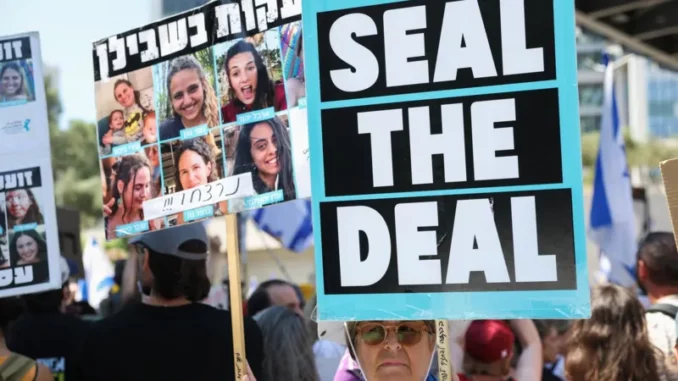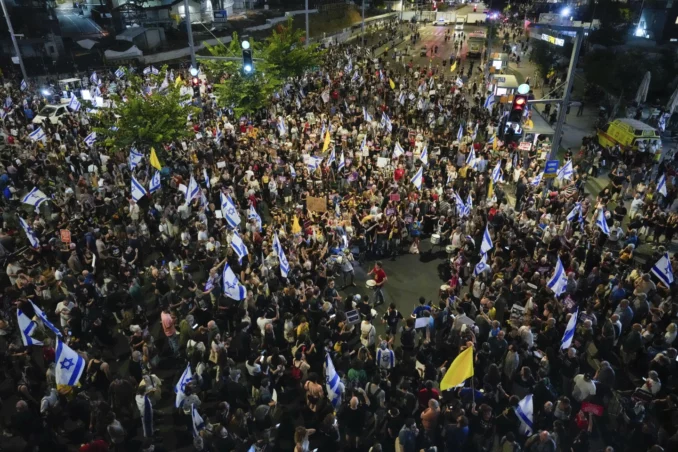Mass protests demand Netanyahu sign accord
Sept. 9, 2024 — Israelis have been demonstrating for over a week against the government of Prime Minister Benyamin Netanyahu regarding his handling of the war against resistance forces in Gaza. The largest demonstration on Sept. 1 brought, according to organizers, a half million demonstrators to Tel Aviv and a quarter million out in the rest of the country. (Al Jazeera, Sept. 8)
The main demand from the masses has been that the prime minister conclude an agreement with Hamas that would include a permanent ceasefire and allow for a return of the remaining Israelis held in Gaza.
The parties of the pro-Zionist opposition to Netanyahu have all raised their own criticism of the war. Some even demanded more aggressive policies against Hezbollah in Lebanon or against Iran. Yet all reports of the mass demonstrations say the main demand is that the regime sign an accord: “Seal the Deal” is on their banner.

Tel Aviv, Sept. 2, 2024.
It should be kept in mind that these are protests inside the area controlled by the Israeli state while it is carrying out a genocidal war — one which has so far failed to achieve the government’s declared objective of smashing the resistance. They have a different dynamic from those protests in the imperialist countries that have been arming Israel, like those in the United States.
It might be best to examine this phenomenon of mass opposition to Netanyahu as representing the result of the gradual exhaustion of a brutal state facing a determined resistance.
While pro-Israeli propaganda dominates in all the imperialist countries, there is no place it is more dominant than in Israel itself among Israeli citizens, those who are not Palestinians.
On the other hand, despite corporate media support for Israel in countries like the U.S., many people have observed horrific images of the Israeli military’s massacres in Gaza on social media. This coincided with an awakening about the oppressive role of Israel and of the U.S. military support for the Israeli state.
The protests at universities, with leadership from Palestinian organizations and some anti-Zionist Jewish organizations, show that thousands of people in the U.S. have been willing to take action to stop what they understand is a massacre of children and other civilians.
People in the U.S. have faced state repression and consequences at work or school for taking action, from the imperialist establishment and from organized pro-Israeli forces. On the other side, they have also found solidarity with peers. And they know that not acting would make them complicit with genocide.
Israeli ‘public opinion’
Mass opinion among Israeli citizens is pro-Zionist and has been inculcated for a lifetime. Many share a narrow nationalism. And the vicious anti-Hamas and anti-Palestinian propaganda — based on big lies — accelerated the hatred of Palestinians after October 7 of last year.
The most aggressive of the Zionist parties, who were part of the Netanyahu government, supported the genocidal attack on Gaza without restraint. Anyone showing opposition to the war regime would be subject to persecution. Not to mention isolation. The only signs of opposition to Israeli occupation came from a handful of youthful military resisters, who refused to take part in the occupation and who expected isolation as well as a few months in prison.
Netanyahu, who faced charges of corruption and might be found guilty once removed from office, took refuge in waging genocidal ethnic cleansing, in refusing a trade of prisoners and in expanding the war. But this had its consequences.
Resistance forces in Lebanon — Hezbollah — drove Israeli residents out of towns near the Lebanon border. Yemenis fired on ships bringing goods to Israel — saying they would stop when the genocide stopped. The mobilization of Israeli reserves slowed the economy. Many Israelis holding other passports left Israel, at least temporarily.
And the resistance of the people of Gaza stunned the Israeli state, despite the horrible weapons turned against them. Now the West Bank population is resisting, as are millions of people in West Asia.
Before, when Israelis were held by the resistance, there would be a trade and a release. (Don’t forget: The Israeli state holds some 10,000 Palestinians in prison, many without even being charged.) This time there was no deal, no release, which caused sorrow that turned to anger against Netanyahu, who began to be perceived not only as a crook, opportunist and autocrat, but also as a danger to themselves.
Growth of opposition
Demonstrations, most of them relatively small, asking for the return of those held in Gaza, had been taking place regularly since last November. Even though these protests implied opposition to the war government, they did not isolate the protesters from most of the population.
This Sept. 1, following the discovery that six of the remaining people held in Gaza had been killed, the protests exploded. A breaking point had been reached. There were even clashes between demonstrators and police when the protest stopped traffic on a highway.
Speaking about the biggest demonstration so far, former Israeli negotiator Gershon Baskin told Democracy Now: “To make that equivalent in the United States, it would be like 25 million Americans taking to the streets.”
Later in the week, government documents were released showing that three of the people killed were on a list to be freed in a potential agreement in May, increasing the anger at Netanyahu.
It’s true that demonstrators who show solidarity with Palestinians are a tiny minority, and there is no guarantee they will gain influence. Photos of the protests showed many demonstrators waving Israeli flags, some wearing “deal now” shirts and none demanding Palestine liberation.
This phenomenon, however, is in motion. It is destabilizing and fracturing the Zionist settler-colonial project. What happens next depends not only on what the Israeli population thinks now, but on the world in the coming months, including what the movement in the U.S. can do. And it’s not over.

Tel Aviv, Sept. 3, 2024. Protesters attend a rally demanding a cease-fire deal.

